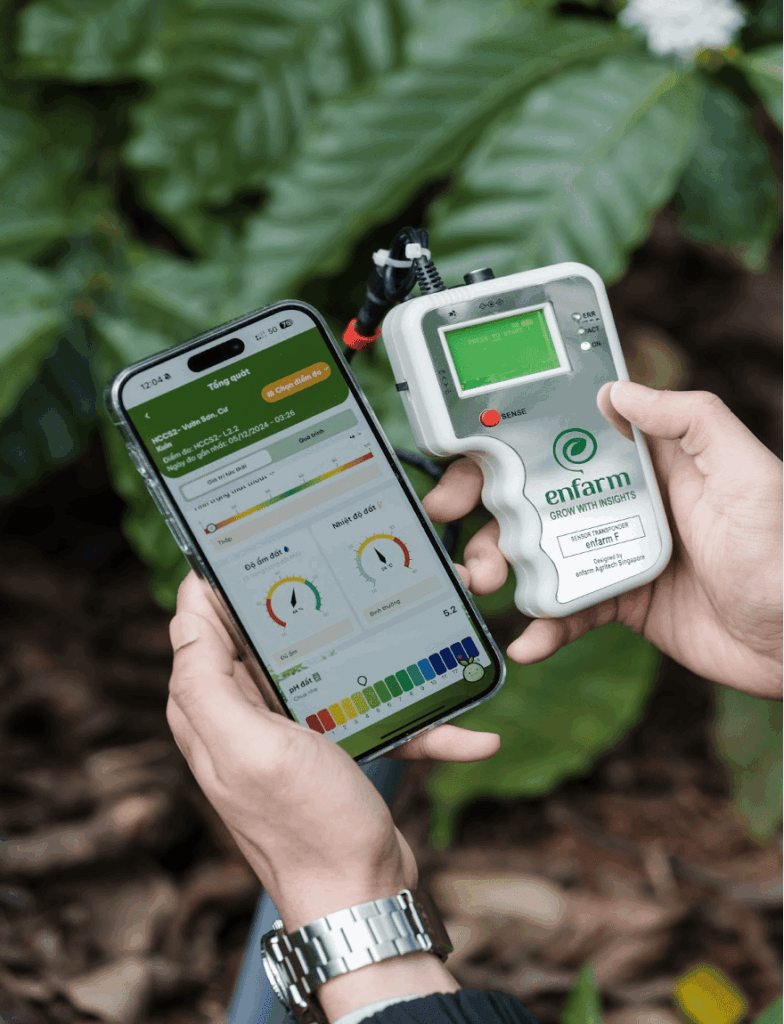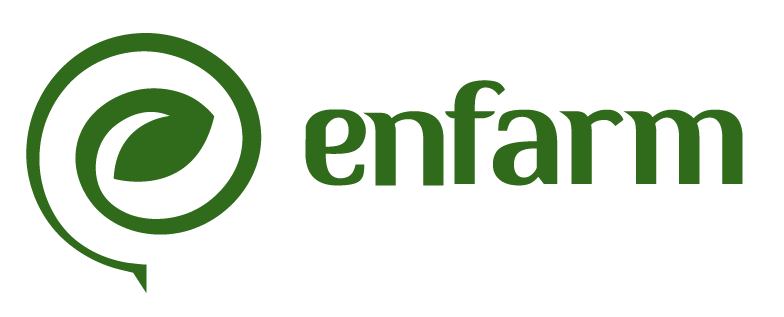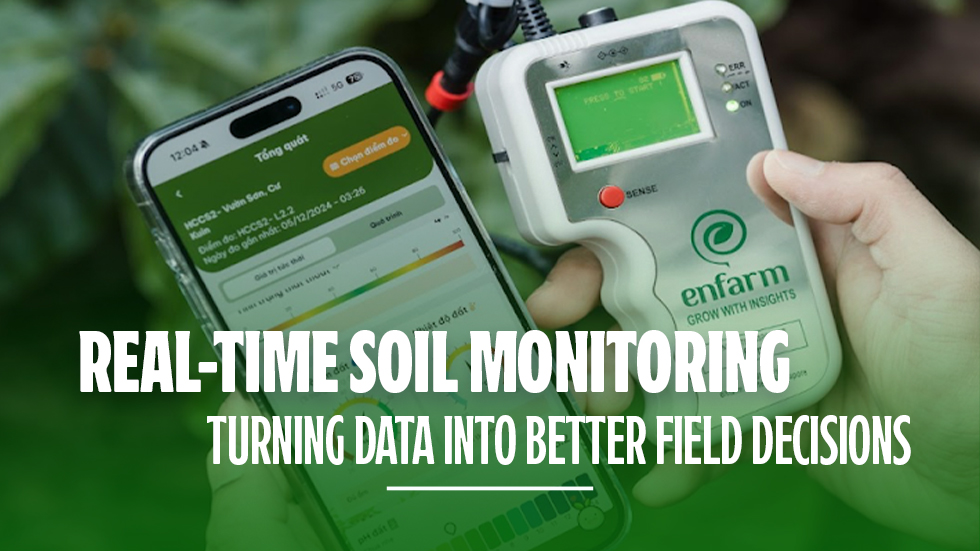Knowledge
Real-time soil monitoring: turning data into better field decisions
When we say “right fertilizer, right irrigation,” what we really aim for isn’t the number on a bag—it’s the amount of nutrients actually dissolved in the soil solution and available to roots at the moment of farming. Enfarm’s core approach is to track the soil environment continuously and calculate a nutrient mass balance: total N-P-K in soil = what you apply + what remains from previous seasons − what’s lost. Crucially, the plant-available fraction is only a small slice of the total and is regulated by CEC, pH, and soil microbes. That’s why the N-P-K a crop can “drink” often differs from the label, and why fertilizer decisions should move with real-time measurements.

Fig. 1: Adopting enfarm’s real-time soil monitoring can help increase yield with less resources.
In the field, day-to-day records of pH–moisture–temperature turn “gut feel” into evidence-based actions. After liming, Enfarm sensors capture the pH curve shifting into an effective range, so growers know when the soil has responded enough for better nutrient uptake and how long until the next intervention; at the same time, moisture logs reveal whether soil is holding water too long or losing it too fast. Continuous monitoring makes pH, moisture, and temperature move from a black box to numbers you can act on.
Field trials show this isn’t just mechanistic theory—it pays on real farms. In Cư Kuin (Đắk Lắk), a 2024 coffee trial with six fertilizer programs (plus a farmer baseline) recorded plots guided by monitoring-based recommendations achieving up to ~30% higher yield while cutting nitrogen by ~25%, slightly increasing phosphorus by ~12% for balance, and reducing potassium by ~60% by leveraging soil residuals. A companion synthesis points the same way: Enfarm’s recommendation framework can deliver ~30% yield gains with 30–40% fertilizer savings.
For high-value fruit like durian, post-harvest data from 30 orchards in Đắk Lắk reveal a consistent nutrient imbalance: 100% applied excess nitrogen, 73% excess phosphorus, and only 3% applied enough potassium. That “over–under” pattern wastes money and also links to fruit quality: bad-pulp incidence rises when N overshoots crop need, while near harvest the soil’s water saturation should be kept below ~70% to reduce defects. In practice, tempering N and keeping moisture in range late in the season are two high-leverage, low-friction fixes.
A deeper reason “one-size-fits-all” often fails: soils differ widely in how they hold and release nutrients. The A/T table (the Available/Total ratio for N-P-K) in the report shows that even within basaltic or ferralitic groups, the capacity to retain and release N-P-K can diverge markedly. The right strategy isn’t to chase a new bag every time, but to improve soil (add organics, neutralize acidity) to lift A/T over time, while tuning formulas and rates by soil group. As A/T rises, each kilogram of fertilizer “yields” more plant-available nutrients to roots—pulling productivity and quality upward.
Methodologically, the takeaway is clear: nutrient status and dynamics depend strongly on management history and irrigation, soil class, weather, and crop phenology. Printed recommendations should be a starting point—then customize with monitoring. Evidence indicates this approach can lift yields by ~30% while saving 30–40% fertilizer—good for margins and for the environment.In short, “real-time soil monitoring” isn’t a buzzword; it’s a new decision model. When pH, moisture, temperature, and nutrient signals become continuous data, growers can cut unneeded applications, add exactly where the soil is short, and pick the right day to irrigate or lime. The result is more produce per kilogram of fertilizer, better fruit with fewer defects, and costs optimized to each field.

Fig. 2: Survey of fertiliser usage in 30 durian farms in Vietnam’s Central Highland
Reference
Li, Y. et al. (2019). Liming effects on soil pH and crop yield depend on lime material type, application method and rate, and crop species: a global meta-analysis. Journal of Soils and Sediments, 19, 1393–1406. (Global quantitative effects of liming on pH & yield).
Enesi, R. O. et al. (2023). Liming remediates soil acidity and improves crop yield and profitability: a review and meta-analysis. Frontiers in Agronomy. (Yield and profitability responses to liming; importance of material and rate).
Gu, H.-H. et al. (2020). Meta-analysis of the relationship between potassium fertilizer and crop quality in China. Journal of Plant Nutrition and Fertilizers, 26(10), 1749–1757. (K effects on °Brix, firmness, sugar/acid ratio; K₂SO₄ vs KCl).
Neilsen, G. H., Neilsen, D., & Herbert, L. (2009). Nitrogen fertigation… affects yield, firmness and color of apples. HortScience, 44(5), 1425–1431. (High N reduces firmness and red color without raising cumulative yield).
Zhang, H. et al. (2021). How Does the Waterlogging Regime Affect Crop Yield? A Global Meta-Analysis. Frontiers in Plant Science, 12, 634898. (Average yield losses under waterlogging; sensitivity to timing/duration).
Pallaoro, M. et al. (2023). Effect of Waterlogging on Growth and Productivity of Fruit Crops: A Review. Horticulturae, 10(6), 623. (Impacts of waterlogging on fruit yield and quality).
Chivenge, P. et al. (2021). Co-benefits of nutrient management tailored to smallholder agriculture. Global Food Security. (Meta-analysis of site-specific nutrient management: yield ↑ ~12%, N ↓ ~10%, profit ↑ ~15%).Tripathi, V. K. et al. (2024). Real-time nitrogen monitoring and management to augment N use efficiency…Soil Security. (Rationale and approaches for real-time N assessment and decision support).


